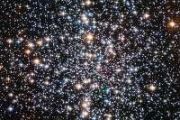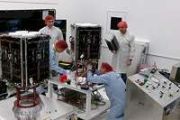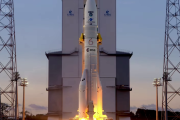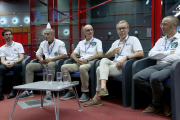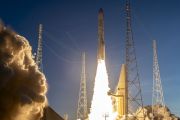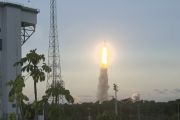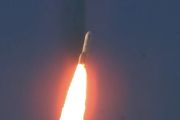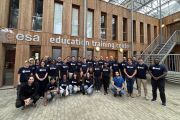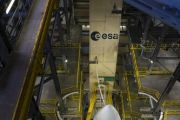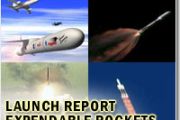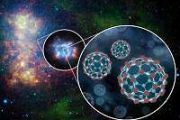
Copernical Team
SpaceX set to hold final launch on New Year's Eve after delay
 In what is expected to be SpaceX's final launch in a record-breaking 2024, the company announced it had delayed its newest deployment of Starlink satellites to New Year's Eve.
The launch, which was slated for early Monday, was scrubbed and rescheduled for Tuesday at 12:34 a.m. EST from the Kennedy Space Center in Florida. SpaceX said the launch window would be open until 1:28 a.m.
In what is expected to be SpaceX's final launch in a record-breaking 2024, the company announced it had delayed its newest deployment of Starlink satellites to New Year's Eve.
The launch, which was slated for early Monday, was scrubbed and rescheduled for Tuesday at 12:34 a.m. EST from the Kennedy Space Center in Florida. SpaceX said the launch window would be open until 1:28 a.m. India rocket launches space docking mission
This request seems a bit unusual, so we need to confirm that you're human. Please press and hold the button until it turns completely green. Thank you for your cooperation!
Press and hold the button
If you believe this is an error, please contact our support team.
185.132.36.159 : ab20ca7d-770e-4afb-b01b-77279b2b
SpaceX winds down 2024 with a pair of Falcon 9 launches
 SpaceX completed back-to-back missions of two Falcon 9 rockets over the weekend, delivering 22 Starlink satellites and Astranis's One to Many Mission into orbit, the 132nd and 133rd missions of the year.
"We're now targeting 134 launches - two shy of our last goal - to finish 2024 strong," Kiko Dontchev, SpaceX's vice president of launch wrote on social media. "Here's to an awesome la
SpaceX completed back-to-back missions of two Falcon 9 rockets over the weekend, delivering 22 Starlink satellites and Astranis's One to Many Mission into orbit, the 132nd and 133rd missions of the year.
"We're now targeting 134 launches - two shy of our last goal - to finish 2024 strong," Kiko Dontchev, SpaceX's vice president of launch wrote on social media. "Here's to an awesome la Teledyne selected as prime contractor for key sensor on LISA Space Observatory
 Teledyne Space Imaging has secured the role of Prime Contractor for the Constellation Acquisition Sensor (CAS) instrument, a critical component of the European Space Agency's (ESA) Laser Interferometer Space Antenna (LISA) mission. Teledyne will supply six CIS220 detectors and control electronics, leveraging its advanced detector and electronics technology. This effort is in collaboration with T
Teledyne Space Imaging has secured the role of Prime Contractor for the Constellation Acquisition Sensor (CAS) instrument, a critical component of the European Space Agency's (ESA) Laser Interferometer Space Antenna (LISA) mission. Teledyne will supply six CIS220 detectors and control electronics, leveraging its advanced detector and electronics technology. This effort is in collaboration with T ispace-EUROPE and ISA partner to deliver advanced reflector technology to the moon
 ispace EUROPE S.A. (ispace-EUROPE) and the Italian Space Agency (ASI) have formalized a payload services agreement to deliver the Laser Retroreflector Array (LaRA2) to the lunar surface. This collaboration aims to facilitate laser ranging experiments that enhance precise lunar position measurements.
The partnership represents the first comprehensive contract between ispace-EUROPE and ASI,
ispace EUROPE S.A. (ispace-EUROPE) and the Italian Space Agency (ASI) have formalized a payload services agreement to deliver the Laser Retroreflector Array (LaRA2) to the lunar surface. This collaboration aims to facilitate laser ranging experiments that enhance precise lunar position measurements.
The partnership represents the first comprehensive contract between ispace-EUROPE and ASI, Robot with charging features to support China's 2028 Lunar program
 Chinese researchers are developing a sophisticated lunar robot with integrated charging capabilities, slated to join the Chang'e 8 mission, planned for launch in 2028.
A collaboration between Dalian University of Technology, Hong Kong University of Science and Technology, and Shenzhen University has led to the creation of a versatile lunar surface robot that will function both as a researc
Chinese researchers are developing a sophisticated lunar robot with integrated charging capabilities, slated to join the Chang'e 8 mission, planned for launch in 2028.
A collaboration between Dalian University of Technology, Hong Kong University of Science and Technology, and Shenzhen University has led to the creation of a versatile lunar surface robot that will function both as a researc Characterizing visual challenges for astronauts at the Lunar South Pole
 NASA is preparing to send humans back to the Moon with the Artemis program, aiming to establish a long-term presence on the lunar surface. The Lunar South Pole (LSP) has been chosen for its continuous line-of-sight communication with Earth, extended solar exposure, and proximity to vital resources like water ice. However, the unique environment of the South Pole presents significant challenges,
NASA is preparing to send humans back to the Moon with the Artemis program, aiming to establish a long-term presence on the lunar surface. The Lunar South Pole (LSP) has been chosen for its continuous line-of-sight communication with Earth, extended solar exposure, and proximity to vital resources like water ice. However, the unique environment of the South Pole presents significant challenges, Fit for service Themis reusable rocket stage reaches key development milestone
 In December 2024, Europe's Themis reusable rocket first-stage demonstrator successfully completed a critical 'full fit-check' at ArianeGroup's Les Mureaux facility in France.
This significant step verified that all core components of Themis - including mechanical connections and interfaces - integrate seamlessly, ensuring the lower and upper segments align and connect as intended.
St
In December 2024, Europe's Themis reusable rocket first-stage demonstrator successfully completed a critical 'full fit-check' at ArianeGroup's Les Mureaux facility in France.
This significant step verified that all core components of Themis - including mechanical connections and interfaces - integrate seamlessly, ensuring the lower and upper segments align and connect as intended.
St Improving precision landing of reusable rockets
 Powered descent guidance (PDG) plays a critical role in enabling reusable rockets to achieve precise landings on Earth. Unlike lunar or planetary landings, endoatmospheric PDG must contend with complex nonlinear dynamics and challenging conditions such as engine thrust fluctuations, aerodynamic uncertainties, and wind disturbances. These factors can significantly affect landing accuracy, increas
Powered descent guidance (PDG) plays a critical role in enabling reusable rockets to achieve precise landings on Earth. Unlike lunar or planetary landings, endoatmospheric PDG must contend with complex nonlinear dynamics and challenging conditions such as engine thrust fluctuations, aerodynamic uncertainties, and wind disturbances. These factors can significantly affect landing accuracy, increas Chang'e-6 study highlights dynamic history of lunar magnetic field
 A study of farside basalts returned by China's Chang'e-6 mission has unveiled evidence of a significant resurgence in the Moon's magnetic field approximately 2.8 billion years ago (Ga). This discovery offers key insights into the lunar dynamo and its impact on the Moon's interior and surface evolution.
The Chang'e-6 mission provided the first basalt samples from the Moon's farside, filling
A study of farside basalts returned by China's Chang'e-6 mission has unveiled evidence of a significant resurgence in the Moon's magnetic field approximately 2.8 billion years ago (Ga). This discovery offers key insights into the lunar dynamo and its impact on the Moon's interior and surface evolution.
The Chang'e-6 mission provided the first basalt samples from the Moon's farside, filling 




